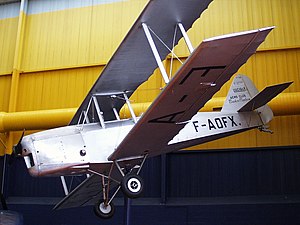Caudron C.270 Luciole
| C.270 Luciole | |
|---|---|

| |
| Role | Sports plane |
| Manufacturer | Caudron |
| Designer | Paul Deville |
| First flight | 1931 |
| Number built | >700 |
The Caudron C.270 Luciole ("Firefly") was a sporting, touring and trainer aircraft produced in France in the 1930s, derived from the C.230.
Design and construction
It was a conventional biplane with single-bay, unstaggered wings of equal span. The pilot and a single passenger sat in tandem open cockpits. It featured a fabric-covered fuselage in place of the C.230's wooden one, and other refinements including revised control surfaces and undercarriage, and an improved and simplified wing-folding mechanism.
Operational history
The type proved immensely successful, with over 700 machines built in the decade leading up to World War II. Of these, 296 were purchased by the French government for its pilot training programme, the Aviation Populaire. Many examples saw wartime service as liaison aircraft, and those surviving the conflict saw postwar use as glider tugs in the Ecole de l'Air.
20th Century Fox used 2 Lucioles in their 1965 film The Blue Max. These had the rear seat converted into a machine-gun position. One of these survives on the American registry.

Variants

- C.270 - first production version with Salmson 7Ac radial engine (82 built)
- C.270/1 - version with Salmson 7Ac2 engine
- C.271 - version with Lorraine 5Pc engine (1 built)
- C.271/2 - version with Lorraine 5Pb engine
- C.272 - version with Renault 4Pb inline engine (52 built)
- C.272/2 - version with Renault 4Pci engine and taller, more pointed tail fin (22 built)
- C.272/3 - version with Renault 4Pdi engine and wheel brakes (15 built)
- C.272/4 - version with Renault 4Pei engine and wheel brakes (21 built)
- C.272/5 - version with Renault 4Pgi engine(80 built)
- C.273 - version with Michel 4A-14 engine (14 built)
- C.274 - version with Chaise 4Ba engine for 1932 Paris Salon de l'Aéronautique (1 built)
- C.275 - main production version derived from C.272/5 but without wing folding (433 built)
- C.276 - version with de Havilland Gipsy III engine
- C.276H - version with Hirth HM 504A-2 engine (2 re-engined from C.276)
- C.277 - similar to C.272/4 with non-folding wings (9 built)
- C.272R - C.275 re-engined with Renault 4Po3 after the war (1 converted)
- C.278 - version with new undercarriage and Salmson 9Nc engine to compete in Challenge 1932 (1 built)
Operators
Specifications (C.272)

General characteristics
- Crew: One pilot
- Capacity: 1 passenger
Performance
See also
Related lists
References
- Taylor, Michael J. H. (1989). Jane's Encyclopedia of Aviation. London: Studio Editions. p. 240.
- World Aircraft Information Files. London: Bright Star Publishing. pp. File 891 Sheet 14.
